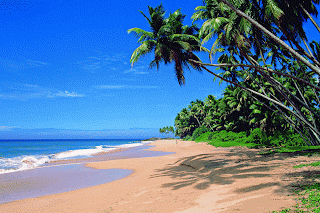Goa..., a tiny emerald land on the west coast of India situated between the borders of Maharastra and Karnataka, is better known to the world at large as the former Portuguese enclave on the Indian soil. With the rule of the Portuguese for over 450 years and the consequential influence of the Latin culture, Goa presents a somewhat different picture to the foreign visitor than any other part of the country. Not only the proportion of Christians (almost all of whom are Catholics) in the total population of Goa much higher than that obtaining in most of the other States; the general way of living is also markedly different. Western influence is evident in the dress and food habits, and the general life of the people is quiet and peaceful. A striking feature of Goa is the harmonious relationship between the two principal religious communities, the Hindus and the Catholics, who have lived together peacefully for generations.
Location: The small state of Goa is in the west coast of the Indian peninsula with a vast coastline of 104 km. An extension to the Konkan coast of Maharashtra, Goa is bounded on the north by Sindhudurg district of Maharashtra state, on the West by the Arabian Sea, on the South by Karwar district of Karnataka state and on the East by Belgaum district of Karnataka state. A place with moderate climate throughout the year, with heavy rainfall in the Monsoon, Goa has gained the name of traveler's paradise with 365 days on a holiday!!
Climate: This is the place in India, where weather does not play an important role! The ambience is the climate! The sultry heat during the months of April and May too do not deter the toursits to flock Goa.
Languages Spoken: Marathi, Konkani, English and Portuguese
Long Distance Code: +91-832
Importance: Beaches and Churches
Area: 3702 sqkm.
Best Time To Visit: October To May & June to September to enjoy the monsoons.
Goa Attractions
Beaches of Goa:
Golden beaches, blue sky and pale hills, silvery sands fringed with palms. The cool breeze, the fishing villages and the beautiful sunset. This is what Goa is, the sea and its sea shores. At every twist and turn of the undulating Goan coast there are alluring little coves or bays each completely different and each with its own special charm. Some of the beaches have all the facilities, right from restaurants to massage parlours to water sports and net surfing cafes, while some do not even have restaurants. You can be with sea and still not leave the materialistic world while on the other hand be with nature in totality. Along the coast are picturesque villages with tall white washed churches and red tiled houses that nestle into the lush green of the Goan country side.
Churches of Goa:
One of Goa's important institutions, the famous and magnificent churches is largely a legacy of Portuguese colonization. Church building was one of the main occupations of the early Portuguese and in fact one of Vasco da Gama's main missions. The most visible legacy of the Portuguese is their churches, not only the imposing monuments, but also more typically white- washed facades nestling among palm trees. Goan Churches have a typical 16th century European architecture with Gothic style influence. The Baroque style architecture also has been heavily used in these churches, with exaggerated interior decorations and intricate details of ornamentation emphasized by gilding and accompanied by sculptured figures.
Temples of Goa:
The Hindu culture of Goa is ancient and the temples dedicated to various deities of Goa date back to the Panadava caves, Shiva temple of 1st century A.D. During the early stages of the Portuguese rule, the Hindu temples of Goa were raised to ground and destructed. There are many temples in the interiors of Goa, as the coastline was the main place of the Portuguese. Many deities had to leave their temples, as the devotees shifted them for the fear of destruction. The architecture of Goan temples is a little different mostly because of historical reasons. The Goan modification lies in the assimilation of local building traditions into this rigid architectural style giving it a special local flavor. One of the special features of Goan temples is the Lamp Tower or Deepmal rising anywhere from two to six storied high. This is said to be a Maratha influence. During festivals these lamp towers burn with innumerous lamps and are a delightful sight. Another distinctive feature is the dome that covers the main shrine instead of the shikhar like in other temples.
The important temples of Goa are:
Anant Narsinha Temple of Veling, Devaki- Krishna Temple of Marcel,Mahalsa Temple in Mardol,
Mahalakshmi Temple of Bandivade and Panaji, Mangesh Temple and the Nagesh Temples, Saptakoteshwar Temple of Narwe and the Mahadev Temple in Tambdi Surla.



Comments
Goa worth the visit. Greetings from Portugal
Goa has always been a haven for travellers. Love the beeches, the food and the people.
A timely post, Sanjeev. I'm just back from a week on a cruise ship (the Royal Clipper) whose crew was almost 100% young men from Goa. Man, they are good sailors!